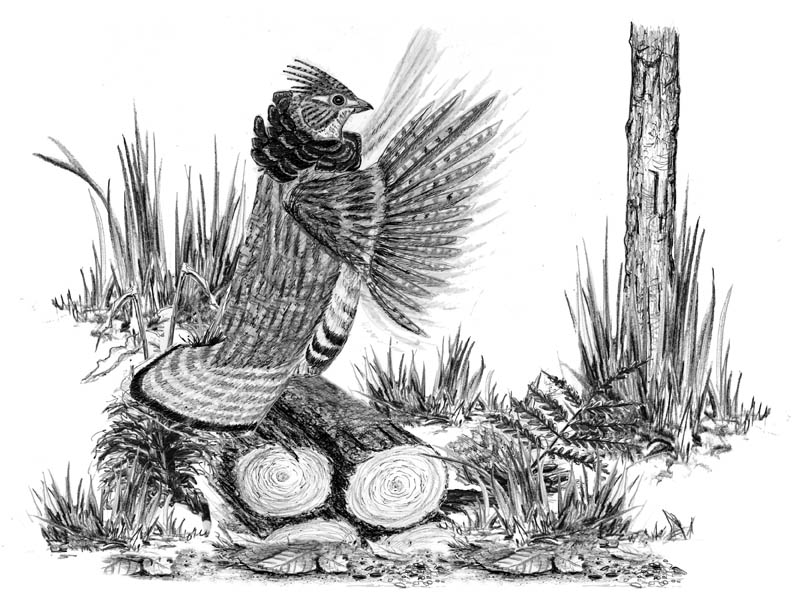
Dear Bird Folks,
Can you please tell me what this bird is (see attached photo)? It was walking across my driveway this morning and I have never seen it before. It looks a bit like a female pheasant. What do you think?
– Olivia, Marstons Mills, MA
I’m jealous, Olivia,
Your mystery bird is a Ruffed Grouse, and I’m jealous. Ruffed Grouse reportedly breed here on Cape Cod, but I’ve never seen one. Even though I’ve seen them in the Scusset Beach State Reservation, which is just over the bridge, that doesn’t count. The birds in Scusset may think they live on the Cape, but if they don’t have to deal with bridge traffic, they don’t get credit for living on Cape Cod. That’s the rule…according to me.
Here in Massachusetts we have three native species of upland game birds: the disappearing (sadly) Northern Bobwhite; the rapidly increasing Wild Turkey; and the seldom seen, and also declining, Ruffed Grouse. (Pheasants were imported from Asia, so they don’t count as native.) Like most birds, grouse are habitat dependent. Not particularly fond of open fields or old-growth forests, they are attracted to something in between. Early settlers clear-cut the land for farms, but as the interest in farming waned, the trees began to grow back. The newly regenerating forests produced the perfect grouse habitat and the birds flourished. Then things turned ugly.
Bobwhites and turkeys like to spend their day picking at food on the ground, but grouse actually spend a fair amount of time off the ground, feeding on the branches of trees. What are they eating up there? Mostly buds, including the buds of fruit trees. This made the grouse the enemy of orchard growers, causing some towns to even put a bounty on the birds. As a result, the state’s grouse population took a serious dip. Today, the birds’ biggest problems are land changes and development. Even with all those problems, the Bay State still has a fair number of Ruffed Grouse. We just have to know where to look, or more importantly, where to listen.
Most Cape Codders are familiar with the sound of the bobwhite. Not too many years ago the male’s “bobwhite” call could be heard all summer long. And even non-birders know a turkey gobble when they hear one. But the vocal skills of the Ruffed Grouse are minimal, sounding more like clucking chickens, at best. But grouse have a better way of being heard. In the spring the male will stand on a stump or log and advertise his territory by “drumming.” But he isn’t drumming on the log itself, like a woodpecker does. Instead, he produces a thumping sound by flapping his wings forward, almost as if he was beating his chest, gorilla-style. The rush of air creates tiny sonic booms and thus, the drumming sound. At first, the drumming starts slowly, but then it rapidly gains speed. Some people say it reminds them of an old tractor starting, but if you don’t happen to have an old tractor, try beating your chest. It will produce a similar sound. (Just make sure no one else is looking, or you’ll have to do a lot of explaining. Believe me, I know.)
Unlike many game birds, both the male and female Ruffed Grouse look alike. They have a ragged crest on their heads and beautiful, semi-circle-shaped tails, which they fan out, tom turkey-style, during aggressive encounters. The Ruffed Grouse earns its name from the ruff of black feathers around its neck. Most of the time the ruff isn’t particularly obvious, but the males can flare them out during courtship. Even though the sexes look alike, there is still diversity in the birds’ coloring. Like Eastern Screech-owls, Ruffed Grouse may have a red, gray or brown color morph. The coloring is not related to age or sex, but gray birds tend to be more common in the snowy north, while the darker birds are more likely to be found in the south, suggesting a camouflage component.
Speaking of camouflage, when the males aren’t drumming, locating a grouse can be a challenge. Their cryptic coloring makes them nearly impossible to spot. When a grouse senses danger, it will remain motionless, holding still until the last second. Then it springs into the air, startling the unsuspecting predator…or birder. This abrupt behavior has earned the grouse the nickname of “heart attack bird.” Sometimes, however, the grouse can be surprisingly bold and take the fight to the enemy. More than once I’ve had a grouse come charging out of the woods, right at me. I assumed the aggressive bird had young ones nearby, but I never saw any babies. I was too busy trying to get my heart rate down to look for them.
You were lucky to see a Ruffed Grouse in your driveway, Olivia. Although the next time you see a strange bird in your driveway, it may not be a bird at all. It could be me, trying one last time to finally see a Ruffed Grouse on Cape Cod. So, please don’t call the cops. I think they’re getting tired of me.
On a different topic:
A few weeks ago I received a very nice note from Marilyn in W. Barnstable. She wanted to know why the birds at her feeder seemed to disappear around midday, as if they were taking a “siesta.” You aren’t far off, Marilyn. Birds alternate between periods of feeding and resting. When they’re full, they’ll take a break and spend time preening and digesting. However, it’s spring, so soon they’ll be raising kids, and there will be no more siestas for a very long time…as all parents know.